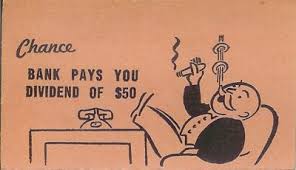Regular readers of my MFI blog know that I have been tracking MFI data for almost 10 years now. One item I have found, since I started tracking in 2006, was that MFI stocks that paid a dividend (I used 2.6% or greater) have out-performed. And if you take a subset of that => those with a larger market cap, they have out performed the outperformance.
So I started four tranches based on that approach last October. The results have trailed the market by a bit in my 13 months. I have always had a nagging concern that the out-performance was somewhat correlated to T Bill rates. As those drop, just naturally larger cap dividend stocks would be more attractive. And it seemed possible that the reverse might be true as well, when T Bill rates rise, they might be less attractive.
Of course, it is always difficult to separate the sheep from the goats. Is the recent poor performance just reflective of stocks like CSCO, GME & QCOM have poor earnings, guidance etc? Perhaps nothing to do with macro items like T Bill rates, but rather a bad run that will revert to the mean?
Here is a table showing the past 15 dividend components of my MFI tracking portfolios:
| Date | Dividend | R3K | MFI |
| 7/25/2014 | 7.8% | 8.7% | 3.3% |
| 8/29/2014 | 3.3% | 1.0% | -2.2% |
| 9/26/2014 | 11.4% | -0.9% | -0.6% |
| 10/31/2014 | 2.7% | 4.4% | 4.3% |
| 11/28/2014 | -9.7% | -0.7% | -2.8% |
| 12/31/2014 | -10.9% | -0.6% | -3.2% |
| 1/30/2015 | -5.2% | 2.2% | 1.4% |
| 2/27/2015 | -12.7% | -3.3% | -8.7% |
| 3/27/2015 | -8.7% | -1.9% | -8.2% |
| 4/24/2015 | -16.0% | -4.5% | -9.4% |
| 5/29/2015 | -13.9% | -4.1% | -12.0% |
| 6/26/2015 | -8.0% | -4.2% | -5.5% |
| 7/30/2015 | -8.5% | -4.2% | 1.8% |
| 8/28/2015 | -0.2% | 1.3% | 5.4% |
| 9/25/2015 | -1.0% | 4.4% | 6.7% |
| 10/30/2015 | -0.6% | -2.5% | -0.6% |
So a little quick math would show that the 12 open dividend portfolios are down an average of 8.0%, versus -1.5% for R3K and -2.9% for MFI in total. If we open up the 4/24 tranche, here are the stocks:
| Stock | Initial Price | End Price | Percent Change | 52 week low | Mkt Cap |
| BKE | 47.16 | 33.78 | -28.4% | 32.32 | 2,308 |
| CLCT | 22.20 | 15.89 | -28.4% | 11.66 | 204 |
| CSCO | 28.37 | 27.98 | -1.4% | 23.03 | 147,184 |
| EGL | 30.24 | 34.05 | 12.6% | 20.94 | 532 |
| GME | 40.03 | 45.94 | 14.8% | 31.69 | 4,384 |
| GORO | 3.29 | 2.24 | -31.9% | 1.99 | 183 |
| IQNT | 19.01 | 19.56 | 2.9% | 14.31 | 648 |
| KING | 16.76 | 17.78 | 6.1% | 11.63 | 5,396 |
| MSB | 15.22 | 8.29 | -45.5% | 8.15 | 200 |
| NATH | 46.49 | 40.74 | -12.4% | 30.20 | 209 |
| NSU | 3.73 | 2.80 | -24.9% | 2.57 | 763 |
| PBI | 22.52 | 21.27 | -5.6% | 18.59 | 4,605 |
| PDLI | 6.67 | 3.94 | -41.0% | 3.43 | 1,131 |
| PETS | 16.80 | 16.91 | 0.7% | 13.20 | 352 |
| PPC | 23.62 | 20.19 | -14.5% | 17.39 | 6,118 |
| QCOM | 67.20 | 52.27 | -22.2% | 49.92 | 111,436 |
| TSRA | 37.96 | 33.45 | -11.9% | 30.62 | 2,029 |
| WILN | 2.56 | 1.10 | -57.1% | 1.08 | 320 |
If you bifurcate by market cap, the smallest 8 are down 19.9%. The larger 8 are down 12.9%. Of course PDLI is a name I have refused to buy for over a year, at least I got that one right.
I have to say, to me it feels more like individual stock issues at this point, rather than a macro issue that dividend stocks are like bonds and will drop in value when rates rise or are expected to rise. I am sticking with the approach - but everyone needs to draw their own conclusions as I am just a guy on a Dell running Windows 10 (just switched to it yesterday).





No comments:
Post a Comment